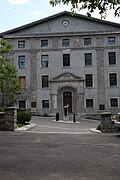Top Qs
Timeline
Chat
Perspective
François Baillairgé
Canadian architect From Wikipedia, the free encyclopedia
Remove ads
François Baillairgé (21 January 1759 – 15 September 1830) was an with expertise in drawing, painting, carpentry, sculpture, and church decoration. Baillairgé was the first artist from Quebec City to complete his education at the Académie royale de peinture et de sculpture in Paris, which he attended from 1779 to 1781.[1]
Remove ads
Life
Summarize
Perspective
The son of Jean Baillairgé, François began an apprenticeship in his father's shop at the age of 14. There he studied and practised woodworking, wood-carving, and architecture. His brother, Pierre-Florent, was also active as a carver and joiner in the business. He also studied at the Petit Séminaire de Québec and then studied in Paris for three years, returning to Lower Canada in 1781.[2] His training in Paris gave him a strong foundation in painting, sculpture, and architecture.
Baillairgé and his father worked together on the interior adornment of the Notre-Dame de Québec Basilica-Cathedral. Their work included the altarpieces, baldachin, statue, throne, and altar.[1]
A great deal of his work was in the field of painting, both religious and secular, and he was very prolific. He achieved a high level of success as a wood-carver, sculptor, and carpenter through the architectural projects he took on while working with his father's workshop.[1][3]
Ballairgé's most notable client was Prince Edward Augustus, the father of Queen Victoria, for whom he sculpted a figurehead.[1]
By 1815, he had introduced his son, Thomas, into the family business and they produced some substantial work together. François also produced many plans for a variety of clients in his work as an architect.
Remove ads
Works
Remove ads
References
External links
Wikiwand - on
Seamless Wikipedia browsing. On steroids.
Remove ads



